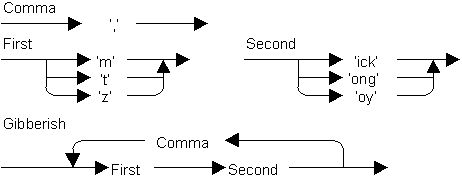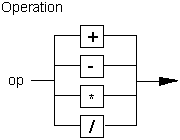
Syntax: The formal rules governing how one writes valid
instructions in a language
Semantics: The set of rules that gives the meaning of
instructions written in a programming language.
A useful tool for accurately describing syntax rule is the syntax diagram. The following is an example to explain how syntax diagrams work.

This syntax diagram shows how to form a piece of gibberish. By following the arrows from entry to exit, we can construct a syntactically correct piece of gibberish such as:
Another way of writing this diagram is as follows:

Syntax diagrams are one way of writing algorithms. If you look closely at the gibberish diagrams, you will see all four of the basic structures of algorithms represented. There are sequences of instructions (first write and 'm', 't', or 'z', then write 'ick', 'ong', or 'oy'); there are selections (places where you can branch to different choices); and there are loops (writing a comma and going back to the start). The second way of writing gibberish diagrams involves subprograms (called Comma, First, and Second) and references to them. The two ways of writing the syntax diagrams demonstrate, once again, that there is more than one way to write any algorithm.
Recursion is employed in syntax diagrams. For example, in the C++ language an Identifier is defined as

Algebraic Expressions
Here is an incorrect expression where the right and left parentheses
are equal in number, but something else is wrong.
a + ( b - c ) + d ) - e + ( x + ( -z )
In addition to problems with parentheses, there may be problems with
the operators +, -, *, / as in the following expressions:
a + * b
a + ( * b + c )
In Algebraic expressions, a term is any numerical value such as 4, 5.7, or -0.0005 or a variable name standing for the same, then

